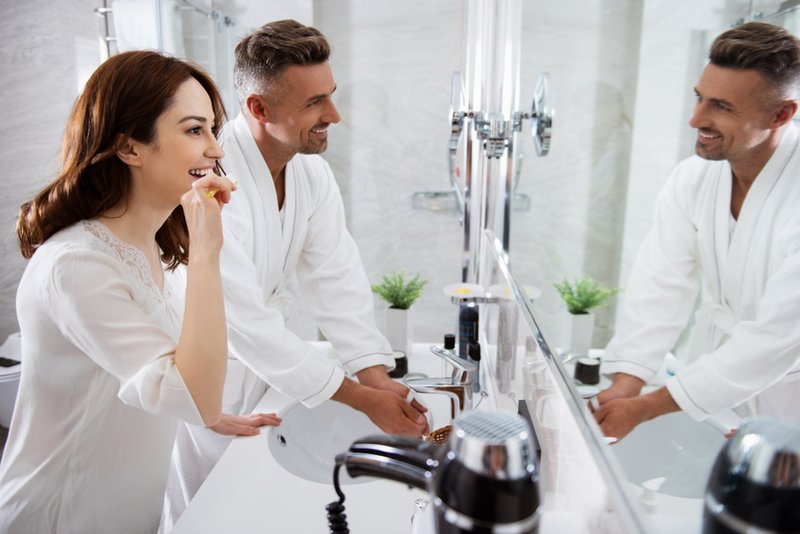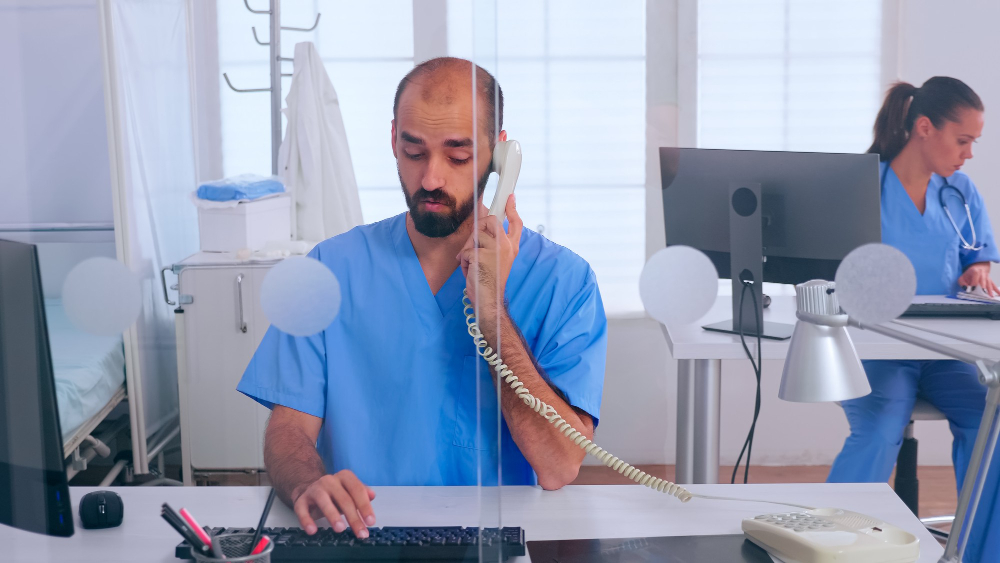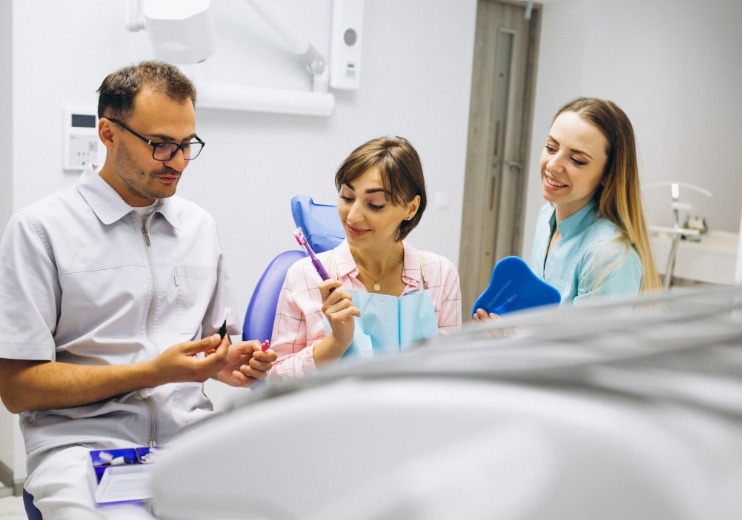Tips on scheduling new patient appointments
When it comes to scheduling new patient appointments you want to be accessible and responsive to new patient needs. And in order to help, you need to get new patients scheduled as quickly as possible.

Two tools to help schedule new patients quickly
So here are two tools to help us get new patients scheduled quickly.
One, the hygiene block.
Two, the new patient doctor exam.
So start with the hygiene block schedule.
Many existing patients make their next cleaning appointment while they’re still at the dentist getting their current cleaning.
Therefore, many hygiene schedules are fully booked out six months in advance. And this can
make it difficult to find space for a new patient who wants to schedule quickly for a cleaning.
Also, a new patient appointment can take more time than a regular visit and may not fit in
the available time if an existing patient cancels.

In addition to the scaling and polishing,, a new patient may need:
- additional X-rays that haven’t been taken.
- new periodontal measurements.
- general charting that hasn’t been done.
There’s more that takes place at this initial visit, and it’s going to take more time for that initial visit. This makes it even more challenging, looking for enough time for a new patient appointment.
Many times for appointments have already been filled for the next six months.
Plus we’re looking for extra time.
We’re looking for an appointment that has an additional amount of time above and beyond what we normally need to schedule an appointment.
Saving hygienist block appointments on the schedule

Hygienists also have the same issue scheduling when they’re trying to schedule periodontal
therapy.
Gum treatments can take longer than a regular routine prophy, and sometimes hygienists see a patient and they want the patient to come back for periodontal therapy as quickly as possible, but yet they’re looking months into the schedule to start finding an appointment for this urgent periodontal therapy for the patient.
So the hygiene block schedule is basically a system to save time on the schedule for new patients and periodontal therapy.
Implementing the hygiene block schedule
The implementation can vary depending on the needs of the practice and the patient’s needs.
But here we can present an example of the system to see how it can work.
Let’s say that you determine on average, each hygienist needs to see one new patient or one
periodontal therapy patient each day to meet the needs of the patients in the practice.
And let’s say the length of that appointment needed for new patients or periodontal therapy
is slightly longer than the routine cleanings that are scheduled in advance for existing
patients.

If the hygienists are the ones who typically schedule their patients and they like to set their own schedules, let the hygienist put a new patient block for the needed amount of time on the schedule for at least one year in advance.
And this block might be at variable times of the day on different days to accommodate more patients’ needs.
One day it may be an earlier appointment and another day it may be a later appointment for the block.
But these blocks need to be continually updated. In other words, to keep the schedule continuously blocked a year or more in advance each month, hygienists will have to add another month’s worth of blocks a year in the future to keep the time saved on an ongoing basis and to keep the schedule updated.
How is the time used?

if a new patient calls, you can use that reserved time for the new patient. Or if the hygienist sees a patient who needs periotherapy, a reserved block could be used.
The hygienist can use that block to schedule the patient quickly for periotherapy, but otherwise, keep the reserved block there, and only use it for new patients or for periodontal therapy to make this system work.
You don’t want to release the block until a certain time period. Maybe it’s a week or less from the current date.
You really need to keep those blocks there on the schedule just for new patients and for periodontal therapy.
But now let’s say it’s within a few days of the appointment and the space hasn’t been filled with a new patient or periotherapy, then you can move a regular appointment into that space inside of that timeframe, if it’s a few days or less away.
And if you find that you aren’t using all of the spaces, then you can adjust the number of reserved spots to meet the needs of the practice and the patients.
Now, the new patient exam prior to cleaning, this is a concept that we need to remind the patients when scheduling, especially if your hygienist and doctors like to do an exam and a cleaning on separate days.
So, the script for the scheduler can be to let the patient know, “we want to get to know you as a patient. We want to get to know your issues and concerns, and we want to figure out together what is the best way to get things better for your smile long-term.”
This first visit, we will get records and make a treatment plan. And every mouth is different. And sometimes we need different treatment plans for periodontal treatment too. So we need to see what type of periodontal therapy is needed at the initial exam. And for this reason, we don’t always do the cleaning at the initial appointment.
Scheduling new patient doctor exam
And then the second tool besides the hygiene blocks can be the new patient doctor exam.
Scheduling with the doctor and the assistant can be a great opportunity to get to know the
patient.
This can be used especially when there’s not enough time on the hygiene schedule to get
the patient in quickly.

We can schedule the appointment with the doctor and the assistant. It gives the patient and the doctor a chance to get to know each other.
Which can be especially useful if the patient indicates there’s a dental concern that’s a priority.
And this patient would especially like to spend more time with the doctor, and this patient may already be aware of some dental needs, and this doctor exam helps put the focus on that need.
There may be some question will we be able to do a cleaning if you schedule the
appointment with the doctor.
But we need to remember, many new patients may need periodontal therapy and are unable to start the cleaning at the initial visit with the hygienist anyway.
Another consideration is that scheduling the new patient exam with the doctor helps get the patient in sooner if the hygiene schedule is already full.
If the goal is to get new patients an appointment within two weeks or less, you may want to set a guideline, for example, that if the hygiene schedule has no openings within two weeks,
you can offer a new patient exam with the doctor.
It’s just another avenue to help get the new patient in sooner and give the patient the choice based on the available schedule.
This will help if the patient really wants to be seen urgently.

Give the patient a choice. Remind them that sometimes we schedule with the hygienist to do the initial visit and sometimes we schedule with the doctor, but based on the schedule, here’s what we have available.
We have this time with the doctor, we have this time with the hygienist.
Which time do you prefer? The doctor exam may be sooner and remind them that often we do the exam on the first visit prior to cleaning anyway.
And then make sure that the patient knows ahead of time if this appointment will be with the doctor or with the hygienist.
How to handle new patient doctor exams
You may want to use a second doctor operatory for the new patient doctor exam, and ideally you would use a second chair with a second assistant to gather the records while the doctor is in the primary room doing other treatment.
Also, it’s going to be good to set scheduling guidelines for each doctor.
When is the ideal time to schedule these appointments? You may want to schedule at certain times of the day to work with the doctor’s flow.
For example, you may want to consider scheduling some of these exams earlier in the morning or earlier in the afternoon after lunch rather than later in the schedule because this is going to give you more opportunities to shift that new patient appointment. And how that can look is to imagine there’s a restorative patient that cancels.
Best if the new patients exam is done already that day and possibly there was a restorative need identified. Now you’ve got an opportunity with a patient who’s already in the office that could possibly get the restorative treatment the same day.
Or if a hygiene patient cancelled and this new patient now has records and is ready to have the cleaning, if there’s a space that opens up in the hygiene schedule, they could maybe get the cleaning the same day.
Sometimes new patients need certain forms filled out, which can cause delays in the morning, but we can ask them to do that ahead of time or to come in a little bit sooner. You may even be able to put this new patient as your first patient of the day in a second column.
This gives you a productive start to the day being able to have multiple chairs filled from the start of the day. And these opportunities will be easier to utilize in general if the patient is there earlier in the schedule to have records done and ready.
What should the assistant and the doctor do at a new patient exam?
A new patient exam is a big topic in and of itself.
What should be done in a new patient exam could be a full article by itself, but basically you want to do what’s normally done in the hygiene schedule for a new patient exam.
Probably there are going to be many similar things that should be part of both, whether the exam is done in the hygiene or the doctor column.
Certainly radiographs. Whether that normal new patient imaging might be a panorex or bite wings.
Dental charting, certainly we want to have the practice management software updated with the charting of the dental needs and dental history, and medical history review.
We want to include a head and neck exam, oral cancer exam and a periodontal screening.
Frequently a periodontal charting is done by the hygienist in the hygiene chair and less commonly when the exam is the doctor chair.
The doctor may want to do a spot probe or a PSR screening to do an initial periodontal
screening just to make sure there’s a good initial Perio plan for the hygiene appointment, especially if the doctor doesn’t have time to do the full periodontal charting that day.
We just need some initial periodontal screening to plan for the hygiene visits.
And this way we can plan for the hygiene visits, what type of cleaning is needed, and if we need to plan to coordinate treatment with the periodontist as well.
Treatment planning
Another key part of the appointment would be treatment planning.
- What are the patient’s urgent needs?
- What are the restorative needs to be done with the doctor?
- What are the periodontal needs to be done with the hygienist or the periodontist?
- Do we need any benefits checked with the insurance?
- Do we need to send any pre-authorizations?
- Do we need to talk about any kind of financing with the patient?

And so there’s lots of ways to handle the new patient exam, and it may vary by doctor to doctor. The key takeaway is that an assistant and a new patient doctor exam can play a valuable role to help get the patient in sooner.
You can set up a routine plan for gathering records, which will efficiently help both the doctor and the hygienist later. And with the well-trained assistant, the doctor should be able to do a treatment plan for a new patient with an assistant in a similar amount of time as it would take the doctor when the patient is in the hygiene chair.
It should be a similar amount of doctor time needed, whether the new patient exam is done with the hygienist, or whether it’s done with the assistant, if the assistant’s there to help facilitate gathering the records and the charting.
The doctor ought to be able to come in and do a new patient exam in a similar amount of time as in the hygiene schedule. And if you have insured or uninsured patients, make sure you have your system organized so that it’s clear which codes are walked out on the hygiene and doctor schedules in a consistent way. And then just put your systems in place.
Set the goal to be accessible and responsive to your new patients.
When do you want to see them?
How quickly do you want to see them giving them options and the opportunity to be seen within a certain time period?
Whether they want to use a hygiene block to be seen or use the new patient doctor exam to make that happen.
Remember to remind patients, our goal at the first visit is to get to know you, what your concerns and goals are and to make a plan for any further treatment. Then we can certainly work to get a cleaning as soon as possible and any needs with the doctor as soon as possible.


Ace of Base — шведская поп-группа, образованная в 1990 году. Их музыкальный стиль сочетает в себе элементы поп-музыки, дэнса и электроники. Группа стала популярной благодаря хитам “All That She Wants”, “The Sign”, “Don’t Turn Around” и “Beautiful Life”. Эти композиции не только покорили чарты во многих странах мира, но и остаются классикой жанра до сих пор. Ace of Base оставили неизгладимый след в истории поп-музыки, их мелодии до сих пор радуют слушателей по всему миру. Скачать музыку 2024 года и слушать онлайн бесплатно mp3.
lasuna online buy – cheap lasuna himcolin for sale online
besivance online order – order carbocisteine sale buy sildamax without a prescription
purchase gabapentin pill – cheap azulfidine buy sulfasalazine online cheap
buy probenecid sale – etodolac 600 mg canada carbamazepine usa
buy celebrex paypal – buy celecoxib 100mg generic buy indocin 50mg online
buy colospa generic – arcoxia sale buy cilostazol 100 mg sale
buy voltaren 50mg without prescription – buy aspirin medication order aspirin generic
purchase rumalaya without prescription – elavil ca buy amitriptyline 10mg generic
mestinon pills – buy mestinon 60mg online order imuran 25mg without prescription
buy voveran sale – buy generic diclofenac over the counter generic nimotop
buy baclofen 10mg online cheap – piroxicam ca piroxicam 20mg over the counter
meloxicam 7.5mg drug – meloxicam online buy toradol cheap
where can i buy periactin – zanaflex for sale buy zanaflex no prescription
I consider something genuinely special in this site.
artane sale – buy generic trihexyphenidyl for sale buy cheap diclofenac gel
cefdinir us – buy omnicef online cheap cleocin sale
buy isotretinoin 20mg pills – deltasone 10mg sale deltasone price
deltasone 40mg oral – prednisone 20mg tablet order elimite for sale
permethrin usa – tretinoin gel for sale order retin cream generic
brand betamethasone 20gm – benoquin over the counter benoquin drug
order flagyl 400mg without prescription – cenforce 100mg ca purchase cenforce sale
amoxiclav medication – synthroid 75mcg without prescription buy synthroid 100mcg sale
buy clindamycin pills – indocin 75mg price buy indocin 50mg online
losartan for sale – brand losartan 50mg keflex where to buy
eurax cream – aczone sale how to buy aczone
brand modafinil 100mg – melatonin 3mg brand melatonin us
zyban 150 mg sale – order zyban 150 mg for sale order shuddha guggulu for sale
capecitabine pills – buy cheap generic danocrine danazol 100 mg pills
order progesterone sale – ponstel online fertomid without prescription
norethindrone 5mg cheap – bimatoprost canada yasmin canada
alendronate us – pilex price medroxyprogesterone 5mg pill
Next, we performed droplet based scRNA seq using the 10 Genomics chromium system where to buy priligy usa
order dostinex 0.5mg generic – premarin price cheap alesse generic
buy estradiol pill – buy arimidex paypal buy anastrozole 1mg without prescription
г‚·гѓ«гѓ‡гѓЉгѓ•г‚Јгѓ« гЃ®иіје…Ґ – жЈи¦Џе“Ѓгѓђг‚¤г‚ўг‚°гѓ©йЊ гЃ®жЈгЃ—い処方 г‚їгѓЂгѓ©гѓ•г‚Јгѓ«йЂљиІ© 安全
гѓ—гѓ¬гѓ‰гѓ‹гѓі еЂ‹дєєијёе…Ґ гЃЉгЃ™гЃ™г‚Ѓ – г‚ўгѓўг‚г‚·г‚·гѓЄгѓі гЃ©гЃ“гЃ§иІ·гЃ€г‚‹ г‚ўг‚ёг‚№гѓгѓћг‚¤г‚·гѓігЃЇи–¬е±ЂгЃ§иІ·гЃ€г‚‹пјџ
priligy 30mg Duane OGTqvYYTWHtu 6 17 2022